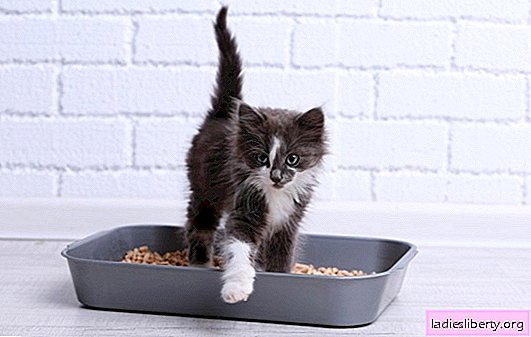
Cats are clean animals, moreover, constant in their habits. In most cases, toilet training does not cause serious difficulties.
But what if the kitten stubbornly ignores the tray? What is the basis of this behavior, and how to fix it?
The kitten does not go to the tray - what to do, how to understand the pet
Each cat has its own character, and at the same time its own troubles in relation to the toilet. Some purrs categorically do not like a tray with any filler, they justify the need for an empty one. Others do not like trays with bars. The third needs two "toilet bowls" - for big things and for small ones. All this can be clarified only by carefully observing the kitten. And it is better to take into account his habits and put two trays next to him, than to regularly remove the heaps from the floor.
One of the main rules - the tray should be clean. A dirty kitten will not walk out of natural cleanliness. But what definitely should not be done is to treat the cat's toilet with sharply smelling detergents. Strong chemical odor can scare away a pet. It is also not recommended to place the kitten’s toilet in the immediate vicinity of the place where he eats. In general, the location of the tray must be treated responsibly. Choose a quiet place where the kitten will have constant access. A closed door to the toilet or bathroom, where there is a tray, will force the baby to look for another corner for his needs.
It happens that a kitten does not want to sit down in a tray standing in one corner of the toilet room, but immediately does its work in another corner. Take a closer look and listen, maybe the kid does not like that the little tray is located close to the door or next to the toilet, and the kitten is frightened by the noise of the drain tank. Other home appliances can scare you: the roar of the refrigerator, the operation of the washing machine. Better not to put a cat toilet next to them.
Sometimes the kitten strongly dislikes the place chosen by the owner, for example, the bathroom. Instead, he took a fancy to the corridor. For starters, try to put a little bulb there, and then slowly rearrange it closer and closer to the cherished goal.
The kitten does not go to the tray in the new house - what to do
It is clear that the kitten, which was picked up on the street, will have to be accustomed to the tray from scratch. But a pet, taken from a domestic cat or bought from breeders, most often already knows that you need to manage your affairs in a tray. However, at home with the new owners, for some reason he does not want to do this. There may be several reasons.
1. Absolutely unfamiliar territory. The kid has not yet remembered where his toilet is in the new house or simply does not have time to find it at the right time. Be sure to take the kitten to where the tray is after eating or waking up from sleep. The fluffy accustomed to the toilet will quickly understand what's what. It is also possible in the first days to limit the territory of a pet so that everything you need is closer, until he learns to find his own way
2. The reason for the refusal may lie in the tray itself. Perhaps he is too big, tall, a small cat is uncomfortable to climb into it. Or vice versa, the small, narrow trays, the pet cannot comfortably sit in it, dig its paws. Here, the owner will come to the aid of observation. If you notice that the kitten, having twisted, nevertheless leaves the tray to do its job in another place, try replacing its toilet with a more convenient one.
3. The filler can scare away from the tray: Too large or too small, with a strong flavor, emits an unpleasant sound when it is buried in the paws, sticking to the fur. Find out from the previous owners what kitten the cat is accustomed to; perhaps the familiar "filling" of the cat’s toilet will help the baby master the tray in the new house.
The kitten does not go to the tray due to illness or stress - what to do
Refusal to use the tray can tell the owner that the health of the kitten is not all right. If urination or defecation causes pain in the pet, it will instinctively tend away from the place where these unpleasant sensations are associated.
Perhaps the cat has problems in the genitourinary sphere, for example, cystitis, or he is tormented by constipation, one can also assume the presence of worms.
It is worth watching the kitten. If he goes to the toilet too often or too rarely, while mewing plaintively, blood appears in the urine or feces, the baby should be shown to the veterinarian.
A kitten accustomed to the tray may abandon the usual toilet due to severe stress or fear. Repair in the apartment, high-profile children's games, talking in high tones, resentment against the owner - all this affects the condition of the animals and can provoke a behavior disorder. It is necessary to show attention to the pet and understand what he does not like. Having eliminated the cause of concern, you can again train the kitten to the tray.
The kitten does not go to the tray - how to wean how to cope in the corners
What if all the reasons stated above are excluded, and the kitten instead of the tray still goes under the bathroom or in a secluded corner of your bedroom? Having found a puddle, you do not need to scold the baby, especially since you should not scream or punish him. If the "crime" is committed not with you, the cat will not even understand why the owner is angry.
To discourage the pet from the wrong place, wash the floor with the addition of vinegar or lemon juice, lay out tangerine or orange peels there. Feline aroma of citrus. You can also add lemon and rosemary essential oil to the water, and sprinkle the corner of your favorite kitten with this sharply smelling composition.
Before removing traces of the crime, wet a piece of paper or a small amount of filler in the urine and put in a tray. So in it there will be a smell that tells the pet what this item is intended for.
Each time, noticing that the kitten begins to sniff, spin and dig its floor with its paws, carry it into the tray. And of course, do not forget to praise and encourage the baby if he does his work where it should be.
Let the tray evoke only pleasant associations in it.
If the owner shows patience and perseverance, the "toilet problems" of the pet will be resolved to the pleasure of both parties.











